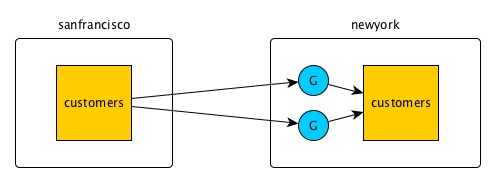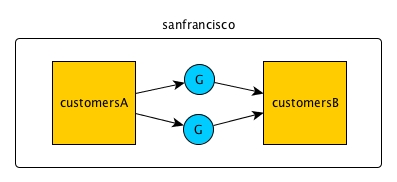Gateways for Replicating HPE Ezmeral Data Fabric Database Tables
In HPE Ezmeral Data Fabric Database table replication, HPE Ezmeral Data Fabric Database replicates updates to tables (binary and JSON) on source Data Fabric clusters to replicas of those tables on destination Data Fabric clusters. Gateways are services that receive these updates and apply them to the replicas. These gateways also propagate updates from JSON tables to their secondary indexes.
- On the nodes of destination clusters, install the gateways.
You must install gateways in the destination clusters.
- If the destination cluster is remote from the source cluster, then the gateways must be in the remote cluster.
- If the destination cluster is the source cluster, meaning that a source table and its replica are located in a single cluster, then the gateways must be in the local cluster.
- If you have secondary indexes on your HPE Ezmeral Data Fabric Database JSON tables, then the gateways must be in the local cluster.
- On the source clusters, configure the gateways by listing the destination cluster and the gateways that are running on them.
How Replication Works
During replication, HPE Ezmeral Data Fabric Database sends source table updates to the gateways on the destination clusters where the replicas of those source tables are located. Gateways batch the updates and then apply them to replicas.
All updates from a source table arrive at a replica after having been authenticated at a gateway. Therefore, Access Control Expression (ACE) on the replica that control permissions for updates to column families and columns are irrelevant; gateways have the implicit authority to update replicas.
HPE Ezmeral Data Fabric Database distributes updates to a destination cluster’s gateways in round-robin fashion. If a gateway is down or unreachable, HPE Ezmeral Data Fabric Database chooses another gateway or retries the operation on the same gateway.
Gateways on nodes in remote destination Data Fabric clusters
In this type of topology, gateways receive updates that are made to source tables, authenticate with the destination cluster on behalf of the source cluster, and apply the updates to the corresponding replicas.
This schematic diagram of basic inter-cluster primary-secondary replication
shows updates to the customers table in the cluster
sanfrancisco being sent to gateways. The gateways
then apply the updates to the replica that is in the cluster
newyork.

The gateways on a destination cluster are not assigned to particular replicas.
They apply updates to all replicas on the destination cluster. For example,
in this diagram, updates to two source tables in the cluster
sanfrancisco are being replicated to two replicas in
the cluster newyork. There are four gateways. Each gateway
receives updates to both source tables, and each gateway applies those
updates to both replicas.

Gateways on nodes within a Data Fabric cluster serving as source and destination
In this type of topology, gateways again receive updates that are made to source tables and apply the updates to the replicas. However, all of this activity takes place within a single Data Fabric cluster.
This schematic diagram of basic inter-cluster primary-secondary replication
shows updates to the customersA table in the cluster
sanfrancisco being sent to gateways. The gateways
then apply the updates to the table customersB.
